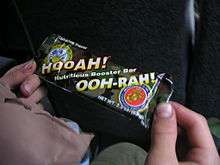Energy bar

Energy bars are supplemental bars containing cereals and other high energy foods targeted at people who require quick energy but do not have time for a meal. They are different from energy drinks, which contain caffeine,[1] whereas bars provide food energy.
Nutrition
Energy in food comes from three sources: fat, protein, and carbohydrates. A typical energy bar weighs between 45 and 80 g and is likely to supply about 200–300 Cal (840–1,300 kJ), 3–9 g of fat, 7–15 g of protein, and 20–40 g of carbohydrates.[2]
.jpg)
In order to provide energy quickly, most of the carbohydrates are various types of sugars like fructose, glucose, maltodextrin, dextrose and others in various ratios. Use of complex carbohydrate sources like oats and barley is limited and such carbohydrate sources are mostly used in protein bars. Proteins come mostly in the form of fast digesting whey protein. Energy bars generally don't contain sugar alcohols, since these bars, due to type of carbohydrate content, don't require low calorie sweeteners to improve their taste. Fats in energy bars are kept to minimum and their main sources are often cocoa butter and dark chocolate.
Usage
Energy bars are used as energy source during athletic events like marathon, triathlon and other events and outdoor activities, where energy expenditure is high, for longer period of time.
See also
| Wikimedia Commons has media related to Energy bars. |
References
- ↑ Warning: Energy Drinks Contain Caffeine by Allison Aubrey. Morning Edition, National Public Radio, 24 September 2008.
- ↑ "Nutrition Bar Comparison Chart" (PDF). Mesa AZ fire department. Archived from the original (PDF) on 27 May 2010. Retrieved 2009-10-21.